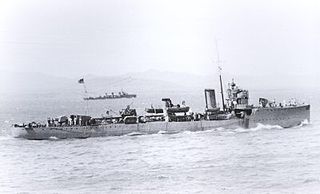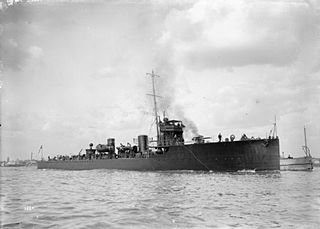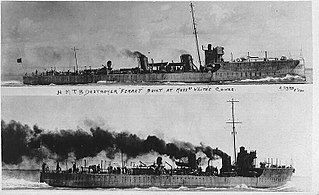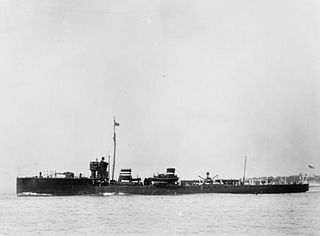
HMS Liverpool was a 4,800 ton Town-class light cruiser of the Royal Navy commissioned in 1909. Named for the port city of Liverpool, the cruiser served continuously in home waters subordinated to the Home Fleet from 1909 through the initial stages of the First World War.

HMS Arethusa was the name ship of her class of eight light cruisers built for the Royal Navy in the 1910s. She saw a considerable amount of action during the early years of the First World War, participating in the Battle of Heligoland Bight and the Battle of Dogger Bank.

HMS Badger was an Acheron-class destroyer of the Royal Navy that served during the First World War and was sold for breaking in 1921. She was the eighth Royal Navy ship to be named Badger, after the mammal of the same name.

HMS Hydra was one of 20 Acheron-class destroyers built for the Royal Navy in the 1910s. Completed in 1912, the ship participated in World War I and was sold for scrap in 1921.

HMS Lizard was an Acheron-class destroyer of the British Royal Navy. She is named for the Lizard peninsula in the county of Cornwall in England. and was the twelfth ship of the Royal Navy to bear the name.

The Active-class cruisers were a trio of scout cruisers built for the Royal Navy shortly before the First World War. They were initially assigned to the First Fleet and became destroyer flotilla leaders in 1914. Amphion and Fearless and their flotillas were assigned to the Harwich Force when the war began in August 1914. They went out on a patrol on the first day of the war and Amphion and her destroyers encountered and sank a German minelayer. On the voyage home, the cruiser struck a mine laid by the German ship and sank. She was the first ship of the Royal Navy to be sunk in the war.

HMS Defender was an Acheron-class destroyer which was built in 1911, served throughout World War I and was broken up in 1921. She was the fifth ship of the name to serve in the Royal Navy.

HMS Acheron was the name ship of the Acheron-class destroyer of the British Royal Navy. She is named after the River Acheron, believed in Greek Mythology to be a branch of the River Styx. She was the fifth ship of the Royal Navy to bear the name.

HMS Phoenix was an Acheron-class destroyer of the British Royal Navy. She is named for the mythical bird, and was the fifteenth ship of the Royal Navy to bear the name. She was the only British warship ever to be sunk by the Austro-Hungarian Navy.

HMS Ariel was an Acheron-class destroyer built in 1911, which served during the First World War and sank in 1918 after striking a mine. Named after Shakespeare's "airy spirit", or the biblical spirit of the same name, she was the tenth and last ship of the name to serve in the Royal Navy.

HMS Beaver was an Acheron-class destroyer of the Royal Navy that served during the First World War and was sold for breaking in 1921. She was the ninth Royal Navy ship to be named Beaver, after the mammal of the same name.

HMS Goshawk was an Acheron-class destroyer of the Royal Navy that served during World War I and was sold for breaking in 1921. She was the sixth Royal Navy ship to be named after the bird of prey, Accipiter gentilis.

HMS Druid was one of 20 Acheron-class destroyers built for the Royal Navy during the 1910s. Completed in 1912 the ship served during World War I and was sold for scrap in 1921.

HMS Jackal was an Acheron-class destroyer of the Royal Navy that served during the World War I and was sold for breaking in 1920. She was the seventh Royal Navy ship to be named Jackal, after the predatory mammal of the same name.

HMS Hornet was an Acheron-class destroyer of the Royal Navy that served during the First World War and was sold for breaking in 1921. She was the seventh Royal Navy ship to be named Hornet, after the insect.

HMS Ferret was an Acheron-class destroyer of the Royal Navy that served during World War I and was sold for breaking in 1921. She was the sixteenth Royal Navy ship to be named after the domestic mammal Mustela putorius.

HMS Forester was an Acheron-class destroyer of the Royal Navy that served during World War I and was sold for breaking in 1921. She was the ninth Royal Navy ship to be named after the traditional craft of forester.

HMS Lapwing was an Acheron-class destroyer of the Royal Navy that served during World War I and was sold for breaking in 1921. She was the seventh Royal Navy ship to be named after Vanellus vanellus, the northern lapwing.

HMS Sandfly was an Acheron-class destroyer of the Royal Navy that served during World War I and was sold for breaking in 1921. She was the seventh Royal Navy ship to be named after the small biting fly of the same name.
HMS Colne was a Thornycroft type River-class destroyer ordered by the Royal Navy under the 1903–1904 Naval Estimates. Named after the River Colne in eastern England, north east of London, she was the first ship to carry this name in the Royal Navy.



















